The Alden Wonderall Company manufactured sturdy children’s clothing, and had its roots in St. Louis Park. Although it moved out of the Park in 1953, Factory Outlet Stores came back to the Texa-Tonka and Miracle Mile Shopping Centers 30 years later, completing the circle from beginning to end of this very successful company.
1945
The Alden Wonderall Company was started in 1945 by mothers Mabel Elstrom and Ruth Pauly. (Alden was the name of Mrs. Elstrom’s husband.) They began production in the Elstroms’ garage, located at 3305 Yosemite Ave So. in St. Louis Park. Mrs. Pauly was from Medicine Lake. The garage factory was set up with the help of the women’s husbands, who were both industrial engineers who worked for Munsingwear. To avoid objections to the “factory” in a residential neighborhood, they hired all the women in the neighborhood to work there.
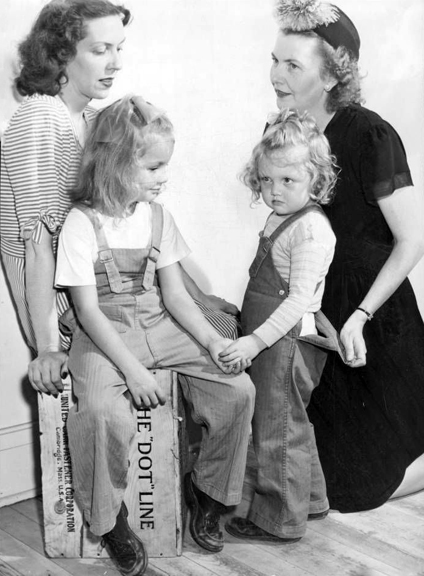
The first design, an overall with a drop seat and 3-inch adjustable waistband, was tested by the Elstroms’ four children and their friends in the neighborhood. “We wanted something that would stand the gaff,” Mrs. Elstrom explained. Their designs for children’s playwear were easy to put on and take off with snaps and loops. They first used War surplus materials: Army khaki for the overalls and parachute nylon to line the bib tops. The women patented their designs, which also included stay-put shoulder straps, and a construction method that didn’t waste any material.
MOVE TO THE WALKER BUILDING
After three months of production in the garage factory, orders started pouring in, particularly from Gambles stores. The company needed a larger space, and again with the help of their husbands, they moved out of the Elstrom’s garage and renovated space at 6524-A in the Walker Building that had previously been occupied by the Jehovah’s Witnesses. They soon had 40 machines operating, many by the same neighborhood women. (Minneapolis Tribune, March 2, 1947)
Although the photo below is dated 1954, after the company had moved to Downtown Minneapolis, the name is still emblazoned on the side of the building.
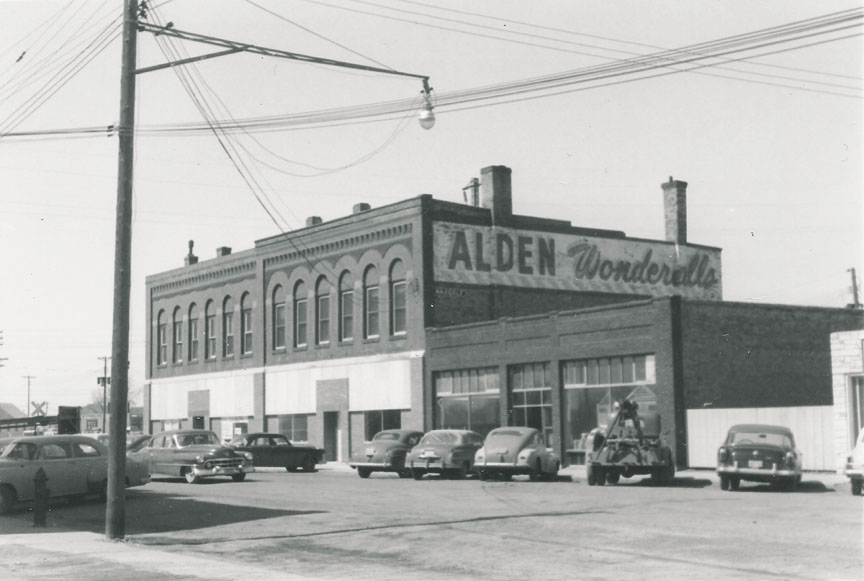
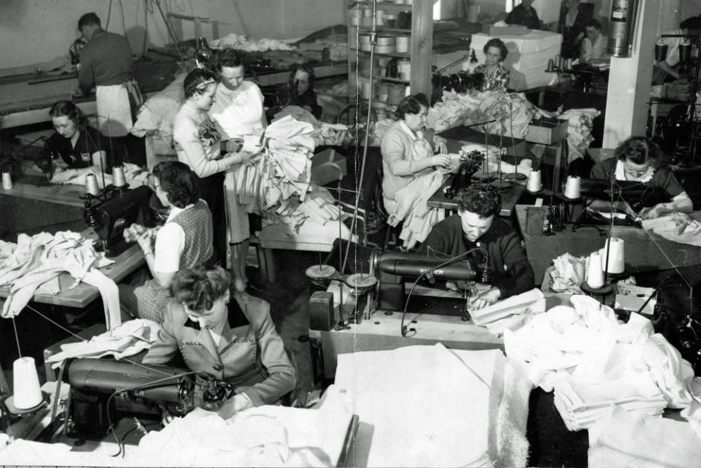
1947
The first ad in the Minneapolis papers was found for “Youngsters’ Corduroy Overalls” at a price of $2.85 at the Dayton’s Boys’ Store.
“Wonderall” Overall, the lightweight, long wearing, washable play tog. Adjustable straps with gripper fasteners at the waist. Tan or red. Sizes 3 to 5. Regularly $4. (Minneapolis Star, January 7, 1947)
By March 1947, Alden Wonderall Company produced more than 60 dozen garments per day with the labor of 40 employees. (Minneapolis Tribune, March 2, 1947)
In September 1947, shares of the Alden Wonderall Company were advertised for sale.
1948
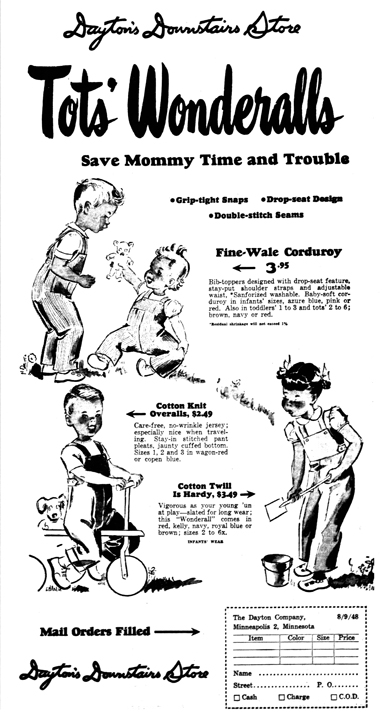
1949
On June 3, 1949, Alden Wonderall appeared on the stock market listing in the Minneapolis Tribune.
1950
In 1950, Simon and Mogilner Company, a St. Paul apparel firm, acquired Alden Wonderall. Mabel Elstrom continued to work as a designer after the acquisition.
1951
The company was “reorganized,” and George J. Rosenberg was named sales manager and assistant general manager of Alden Wonderall Co. The company announced that a general expansion program would be undertaken, with an increase in production and a larger sales force. The factory was still in St. Louis Park. (Minneapolis Tribune, March 15, 1951)
Rosenberg, who had 30 years of experience in the garment industry, changed the line from the basic, unadorned coveralls to cute, fashionable playwear that had themes every year, usually having to do with children’s stories and fairy tales. In 1951, the company was bringing in about $300,000/year in gross revenue. By 1953 that number had risen to $3 million. (Minneapolis Tribune, March 27, 1983)
1953
THE MOVE DOWNTOWN
By April 1953, the factory at the Walker Building covered two floors and employed 110 people, but could not keep up with orders and had to withdraw its lines early for the past few seasons. This necessitated bigger quarters, and in June 1953 the plant was moved to 600 First Ave. North, 6th Floor. This had been the Produce Exchange Building, that dated back at least to 1895, although the main eight-story structure appears to have been built in 1912. In the mid 1950s, the other tenants were also clothing manufacturers. The new space afforded 15,000 sq. ft., allowing the company to more than double its production. Move date was expected to be June 1. Mabel Elstrom was still a designer at the firm. (Minneapolis Tribune, April 12, 1953)
1954
In 1954 an additional factory was opened in Buffalo, Minnesota, which had previously housed another apparel manufacturer. This was a rented, three-story building that had 18,000 square feet and could hold 100 machines. It would be replaced in 1958.
1956
By 1956 the company sold millions of “infants’ and children’s play togs” annually in every state and overseas. There were were sales offices in several cities around the country. The company employed 150 people. (Minneapolis Tribune, March 18, 1956)

In September 1956, George J. Rosenberg and Philip E. Bass became partners in Wonderalls, continuing in their previous executive positions. Rosenberg was General Manager of the company and Bass was Production Manager. Both joined the firm in 1951 when the company was reorganized. The company had about 200 employees at the time. (Minneapolis Tribune, September 24, 1956)
1958
General Manager George J. Rosenberg was presented with Filene’s “Foscar” Award for his fashion contribution to the infants and children’s wear industry. The award was made to him at the prestigious Boston Department Store. (Minneapolis Tribune, March 19, 1958)
George J. Rosenberg, now identified as President of the company, announced that Wonderalls would build its own building in Buffalo, to replace the rental building that presently accommodated 100 machines. The new plant, yet to be sited, would hold twice that number, bringing its share of production (versus the Downtown Minneapolis plant) from 40 percent to 70 percent. (Minneapolis Star, August 18, 1958) A subsequent article indicated that the new plant was built on the same site as the old one. (Minneapolis Tribune, March 27, 1983)
1959
The contracts were signed for the new Buffalo factory, at a cost of $190,000. The one-story building would measure 180 ‘ long by 120’ wide. The Architect was Liebenberg & Kaplan, Minneapolis. The location was not given. (Minneapolis Star, January 1, 1959)
1960
President Rosenberg announced that the company was in need of a third plant in Minnesota to augment those in Downtown Minneapolis and Buffalo. As of April he had visited seven communities. (Minneapolis Star, April 1, 1960)
1963
Willmar Opportunities, a private group organized to attract industry, announced that it would build a plant for Wonderalls in its Industrial Park. The plant would measure up to 40,000 square feet. At the time, the company employed 82 people in a makeshift factory in the basement of the Willmar Auditorium. That number was expected to increase to 250 when the new plant was completed.
The company also leased an additional 15,000 square feet at its factory in Downtown Minneapolis, giving it 50,000 square feet there and accommodating 125 employees. 200 people were at work in Buffalo. (Minneapolis Tribune, October 1, 1963)
1968
According to classified ads, the factory in Paynesville was up and running in about October 1968. An article indicated that the plant was opened in 1969 and was previously used as a clothing manufacturing plant. (Minneapolis Tribune, March 27, 1983)
1970
In 1970 the company bought its Downtown building at 600 First Ave. N, which it had rented for 17 years. The eight story building had 125,000 square feet. It may have been known as “the Wonderall Building.”
1971
In 1971 there were two “Lobby Fabric Shops:” one at the Downtown headquarters building, and one at 8124 Minnetonka Blvd. in the Texa-Tonka Shopping Center in St. Louis Park.
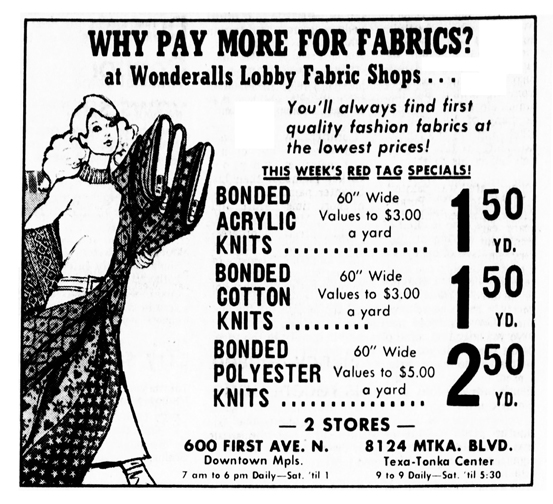
1977
In 1977, President Rosenberg wrote a strongly-worded letter to the editor, in which he spelled out a number of factors that were making it increasingly difficult to survive in business in Minnesota.
- The high price of labor, since almost all industry in Minnesota is unionized, while most in the South is not;
- Minnesota’s high corporate income tax;
- The state’s high workmen’s comp premiums, already the highest in the country and proposed to be increased another 79 percent;
- Plans for a higher Federal minimum wage;
- Additional increases to Social Security;
- Minnesota courts that are the most lenient in the country with regard to worker’s comp claims. He claimed to have tremendous evidence of fictitious or illegitimate claims that are costing industry in the state tens of millions of dollars every year. (Minneapolis Star, November 22, 1977)
1978
The last profitable year for Wonderalls was 1978. Interest rates were forced up by inflation, sometimes between 20 and 24 percent. Loans were taken out to buy materials each year and paid back when products were sold, putting the crunch on the company’s finances. (Minneapolis Tribune, March 27, 1983)
1979
Simon and Mogliner Company, who still owned 50 percent of Wonderalls, decided they wanted Rosenberg to buy them out or liquidate the business. Rosenberg was forced to pay them $905,000 to buy them out. As a result of this heavy debt, Rosenberg had to cut the product line in half and lay off much of his sales staff and production workers. He negotiated an agreement with the Union for reductions in wages and benefits for employees at the Buffalo plant, but the employees responded with a slowdown. (Minneapolis Tribune, March 27, 1983)
1981
The company was using its Outlet Store that was in its Downtown building for half price sales, fabric sales, and consignment sales.
In June 1981, Rosenberg walked into the Buffalo plant and announced that it would be shut down. He did not notify the Union first. He began liquidating his inventory and equipment in August. (Minneapolis Tribune, March 27, 1983)
It is unclear when all manufacturing was discontinued, but all indications are that it was in 1981.
Starting on November 1, 1981, the equipment and fixtures from three factories (presumably Buffalo, Willmar, and Paynesville) were advertised to be liquidated in Buffalo. The “Garage Sale” ad said that the company was discontinuing manufacturing in Minnesota.
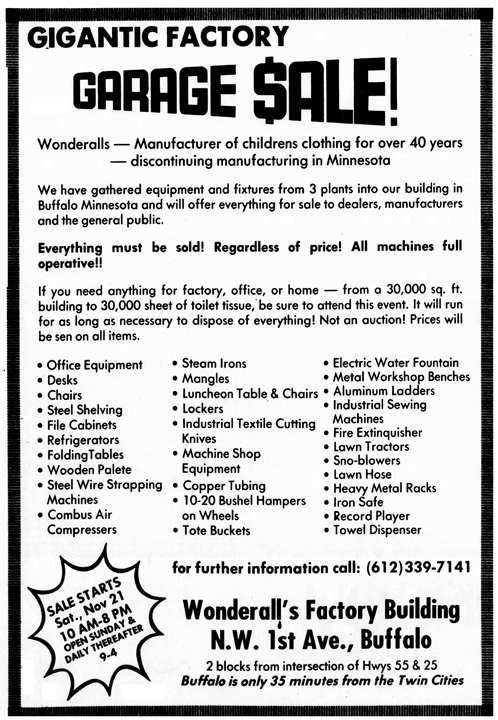
1982
Partners George J. Rosenberg and Phillip E. Bass sold the Downtown building in January 1982 for $1,375,000 to a corporation.
Times were hard in the garment industry and manufacturers left the state in droves. By 1982, only 4,900 Minnesotans worked in the apparel industry. Many of the companies had moved overseas or to the South where non-union workers could be paid less. (Minneapolis Tribune, March 27, 1983)
In the summer of 1982, the Amalgamated Clothing and Textiles Workers Union, which represented the factory workers, filed charges with the labor relations board stating that Rosenberg violated the Union contract by not notifying the Union that he was shutting down the Buffalo plant. The Union also charged that Rosenberg did not provide vacation and holiday pay to some employees. Rosenberg did not dispute the charges. (Minneapolis Tribune, March 27, 1983)
1983
On March 27, 1983, Josephine Marcetty of the Minneapolis Tribune wrote a long piece entitled “Owner still enraged over closing of apparel firm,” about the decline and fall of Wonderalls, and the factors that went into it. Many of the points are covered above. High labor costs, intense competition, and finally high interest rates were cited as the main reasons for the loss of the company. Wages were kept down by the low profit margins and intense competition in the industry, not to mention lower-cost imports from other countries. “And in Minnesota, where the labor force is well-educated and relatively skilled compared with many other states, the demand for wages grew progressively greater during the flush of economic growth in the 1970s,” according to Sung Won Sohn, chief economist at Northwestern National Bank of Minneapolis. But the conclusion was that Minnesota did not have the environment that would allow a garment manufacturing business to grow and that unions were not really to blame. (Minneapolis Tribune, March 27, 1983)
In response to Marcetty’s piece of March 27, Rosenberg wrote a Letter to the Editor that placed the blame for the loss of his company squarely on the face of the Unions, and in particular, Union graft. “Industry in general could remain competitive were it not for the millions of dollars skimmed off the top for union operations.” He insisted that Minnesota should be made a “right to work” state, where workers could “decide whether they want to pay union dues for little or no services rendered.” (Minneapolis Tribune, July 29, 1983)
The Grand Opening of a factory outlet store was announced on October 15, 1983, at 5217 Excelsior Blvd. at the Miracle Mile Shopping Center in St. Louis Park.
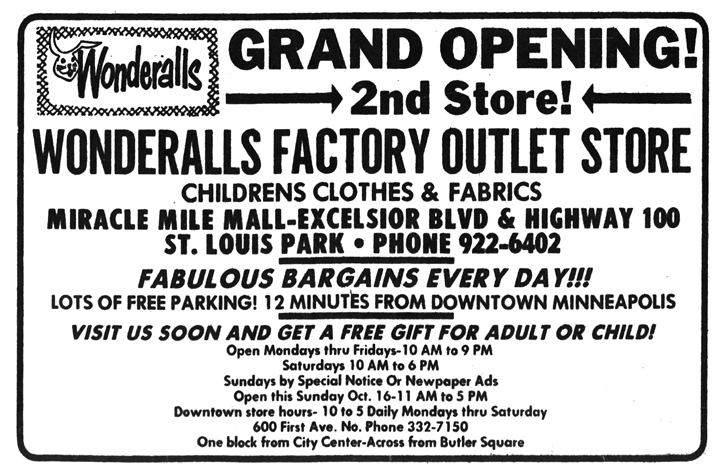
The liquidation of the Downtown factory was announced on December 9, 1983 in the Minneapolis Tribune. The building is now the site of the Target Center, built from 1988 to 1990.
1984
In February 1984, another outlet store was announced at 26 Hennepin Ave. at First Street in the Berman Buckskin Building.
On May 29, 1984, Wonderalls, Inc. filed Chapter 7 (liquidation) bankruptcy, showing $5,000 in assets and $54,366 in liabilities. George J. Rosenberg was the President to the end. (Minneapolis Tribune, June 11, 1984)
